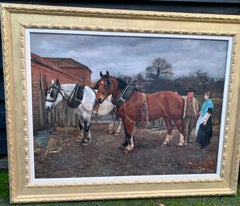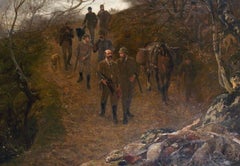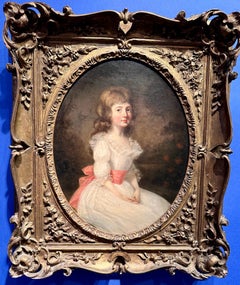William Edward Millner Art
to
1
2
2
2
1
1
Overall Height
to
Overall Width
to
1
2
2
1
1
1
1
1
2
2
6,997
3,373
2,513
1,212
2
2
1
1
Artist: William Edward Millner
19th century landscape/portrait horse with army officer, William Edward Millner
By William Edward Millner
Located in York, GB
Portrait of a bay horse with army officer seated on a drinking trough, signed with monogram and and dated 81', inscribed verso 'by W E Milner, Gainsborough', oil on canvas.
The size overall being 44 x 57 cm (17.5 x 22.5 inches) whilst the image is 35 x 48 cm ( 19 14 inches )
In very good condition housed in a gilt frame.
William Edward Millner...
Category
19th Century Old Masters William Edward Millner Art
Materials
Oil
Victorian English 19th century farm yard scene with Shire Horses and a couple
By William Edward Millner
Located in Woodbury, CT
William Edward Millner was born in 1849 in Lincolnshire, and was a Victorian painter of landscapes and rustic genre.
He worked his entire life ...
Category
1870s Victorian William Edward Millner Art
Materials
Canvas, Oil
Related Items
Return of the Guns Victorian Shooting Party signed oil painting
By John Charlton
Located in Cirencester, Gloucestershire
Very fine, large scale original Victorian oil painting on canvas, depicting a traditional shooting party, "The Return of the Guns". The painting is ...
Category
Late 19th Century Victorian William Edward Millner Art
Materials
Oil
H 30 in W 44 in D 1 in
18th century Portrait of a young girl, Miss Cator in a landscape, white dress
By John Russell
Located in Woodbury, CT
Portrait of a young British Girl, in her white dress with Pink Sash.
Choosing to acquire an 18th-century portrait of a young girl by English artist John Russell is an opportunity to...
Category
1780s Old Masters William Edward Millner Art
Materials
Canvas, Oil
Free Shipping
H 21 in W 18 in
Portrait of a Lady by Fountain in Landscape - Dutch Old Master art oil painting
By Nicolaes Maes
Located in London, GB
This superb Dutch Old Master portrait oil painting is attributed to circle of Nicolaes Maes. Painted circa 1670, the painting is of a lady, sat by a classical fountain with statue an...
Category
1670s Old Masters William Edward Millner Art
Materials
Oil
19th Century oil painting of horses & grooms outside a coach house
By Henry Barraud
Located in Nr Broadway, Worcestershire
Henry Barraud
British, (1811-1874)
Horses & grooms at Mount Mascal
Oil on canvas, signed
Image size: 15.25 inches x 29.25 inches
Size including frame: 21.25 inches x 35.25 inches
...
Category
19th Century Victorian William Edward Millner Art
Materials
Canvas, Oil
H 21.25 in W 35.25 in D 2 in
Portrait of a Gentleman - British 18th Century Old Master art oil painting
By Lemuel Francis Abbott
Located in London, GB
This superb British Old Master portrait is by noted artist Lemuel Francis Abbott. Painted circa 1790, the composition is a half-length standing portrait of a gentleman gazing to his ...
Category
1790s Old Masters William Edward Millner Art
Materials
Oil
Portrait of Major General James Hanson Salmond - British 18thC art oil painting
By Sir Thomas Lawrence
Located in London, GB
This superb British Old Master oil painting is attributed to circle of Sir Thomas Lawrence. Painted circa 1795, the sitter is Major-General James Hanson Salmond (1766–1837) an office...
Category
1790s Old Masters William Edward Millner Art
Materials
Oil
Portrait Gentleman Black Coat Orange Sash, Dutch Old Master, Oil on Panel c.1650
By Bartholomeus van der Helst
Located in London, GB
This exquisite portrait of a gentleman depicted in a sumptuous black coat edged with silver and slashed sleeves is an excellent example of the type of portrait fashionable in England and the Low Countries during the 17th century. The confident pose, striking orange sash - the colour of the house of Orange Nassau - and the leather gorget imbue the sitter with a sense of masculinity and power. The profusely decorated costume is of the highest quality and de rigueur of an elite class - the artist has carefully cultivated this portrait to emphasise the sitter’s wealth and standing in the society that he belonged to. The casual pose, with one arm resting on a hip, is much less formal than earlier decades, and it speaks of ‘sprezzatura’ – one’s appearance should not appear laborious, but instead, effortless.
The oil on cradled panel portrait can be dated to circa 1650 based on the hairstyle and the attire - small falling collar, short doublet (doublets reduced in size to just below the ribcage in the late 1650’s), and the type of slashed sleeves with the sleeve seams left open to reveal the white fabric.
The demand for portraits in the Netherlands was great in the 17th century. Bartholemeus van der Helst was considered to be one of the leading portrait painters of the Dutch Golden Age surpassing even Rembrandt as the most sought-after portraitist in Harlaam. The Dutch Golden Age, roughly spanning the 17th century, was a period when Dutch trade, science, military, and art were among the most acclaimed in the world. Dutch explorers charted new territory and settled abroad. Trade by the Dutch East-India Company thrived, and war heroes from the naval battles were decorated and became national heroes. During this time, The Dutch Old Masters began to prevail in the art world, creating a depth of realistic portraits of people and life in the area that has hardly been surpassed. The Golden Age painters depicted the scenes that their discerning new middle-class patrons wanted to see. This new wealth from merchant activities and exploration combined with a lack of church patronage, shifted art subjects away from biblical genres. Still life’s of items of everyday objects, landscapes, and seascapes reflecting the naval and trade power that the Republic enjoyed were popular. The new wealthy class were keen to have their portraits commissioned and many artists worked in this lucrative field. Such was the popularity of art that everyone had a painting, even the humble butcher, and hundreds of thousands of paintings were produced.
By tradition the sitter is Maarten Tromp (1598-1653) who was an Admiral in the Dutch Navy (the reverse of the portrait contains an old handwritten inscription “van Tromp”). Certainly, the distinctive orange sash is similar to those worn by officers of the Dutch army in the Netherlands who served under the Princes of Orange and the House of Nassau. However, it should be noted that the physiognomy differs from other images of Tromp.
Tromp was the oldest son of Harpert Maertensz, a naval officer and captain. He joined the Dutch navy as a lieutenant in July 1622 and was later promoted from captain to Lieutenant-Admiral of Holland and West Frisia in 1637. In 1639, during the Dutch struggle for independence from Spain, Tromp defeated a large Spanish fleet bound for Flanders at the Battle of the Downs, which marked an enormous change - the end of Spanish naval power. He was killed in action during the First Anglo-Dutch War in 1653 where he commanded the Dutch fleet in the battle of Scheveningen.
Gloves were an absolutely vital accessory and the elaborate pair in this portrait are embellished with threads of silk and precious metals and salmon-coloured lining. He wears only one glove and holds the other, providing an opportunity to better display the cuffs and detail on his right wrist and forearm. The gloves are probably made from the most prized leather which came from Spain, in particular from Cordova. Cordovan leather was tanned with a special vegetal process that left it both highly impermeable and divinely soft. King Charles I, posed in a rather relaxed manner for Daniel Mytens’s portrait in 1631, is wearing gloves and boots in matching Cordovan leather. The hide is thick, but you can see just how supple it is from the way the gauntlet dimples and the long boot legs fold over themselves, rippling and wrinkling at the ankles.
Apart from keeping hands warm the use of gloves during the 15th through the 19th centuries were full of symbolism and they were worn regardless of the season. They kept the skin unblemished - soft, smooth hands were considered highly attractive. This combination of necessity and proximity to bare skin made gloves a deeply personal gift and they took on a strong symbolic significance and were regarded as emblematic of fidelity and loyalty for hundreds of years. Such was the importance of their symbolism was that some gloves were never intended to be worn at all. Their luxury made them ideal gifts at court, and so in the 15th and 16th centuries, ambassadors often presented them as symbols of loyalty.
Until the mid-19th century, it was customary to give gloves as tokens to guests at weddings and to mourners at funerals. Gentleman often gifted their bride-to-be with a pair of gloves (the obligatory gift) and were handed over at the betrothal and put on display before the wedding took place. It was probably their direct contact with the skin that led to the eroticism of gloves. Not only were pairs often exchanged between lovers, but from the 16th to the 18th centuries, it was common practice to remove one glove and give it as a gift to a favourite. The idea of the item being presented still warm from the wearer’s hand is certainly suggestive. Following the death of King George IV, his executors purportedly found over a thousand mismatched ladies’ gloves among his possessions.
The sentiment of a 17th-century poem reveals the popularity of the practice: “Come to our wedding to requite your loves / Shew us your hands and we’ll fit you with gloves.” Such generosity might be pricey for the hosts, but gloves of varying quality could be offered depending on the status of the recipient. Pairs made with the finest Spanish leather might be reserved for immediate family, while coarse sheep’s leather could be distributed among the servants and tradesmen. The apportioning of quality according to class provided a very clear message of the gloves’ intended use. For refined guests, they were decoration; for the lower classes, they were functional.
Bartholomeus van der Helst...
Category
17th Century Old Masters William Edward Millner Art
Materials
Oil, Wood Panel
H 38.59 in W 31.89 in D 2.76 in
19th Century French Romantic Oil Family Camp Fire Dogs & Sticks
Located in Cirencester, Gloucestershire
Artist/ School: F Bedo 19th Century European - dated 1878
Title: A Resting Place
Medium: signed oil on canvas, framed
Size: 18 x 14 inches, plus the frame
Provenance: private col...
Category
19th Century Victorian William Edward Millner Art
Materials
Canvas, Oil
"Carriage Ride" by Americo Makk 24 x 18 inch oil on canvas
By Americo Makk
Located in Atlanta, GA
Item is in excellent condition and has only been displayed in a gallery setting. Item includes frame; framed dimensions are approximately 33 x 27 inches.
Americo Makk...
Category
21st Century and Contemporary Victorian William Edward Millner Art
Materials
Oil, Canvas
Portrait Knight Paint Oil on canvas 17th Century Lombard school Old master Italy
Located in Riva del Garda, IT
Lombard painter of the 17th century
Portrait of a Knight in Armour
Oil on canvas
81 x 70 cm./ Framed 93 x 82
A handsome gentleman in armour, immortalised in an authoritative and pr...
Category
17th Century Old Masters William Edward Millner Art
Materials
Oil
Portrait of a Young Gentleman and Pet Dog c.1680, Antique oil on Canvas Painting
By (Circle of) Mary Beale
Located in London, GB
The portrait genre was valued particularly highly in English society. Neither landscapes nor allegorical pictures were ever priced so highly at exhibitions and in the trade as depictions of people, from the highest aristocracy to scholars, writers, poets and statesmen. This charming portrait, presented by Titan Fine Art, of a fashionable young gentleman and his faithful pet is an excellent example of 17th century child portraiture in England. There is a remarkable beauty and sensitivity to the portrait. The face, particularly well rendered, has captured the character of this young man – both charming and at the same time mischievous.
Only the playful attention of a small dog suggests anything less than patrician dignity. Symbolism was important in portraiture and it provided a pointed and aspirational narrative that would not have been lost on contemporary viewers. For example, the presence of the dog, which was likely the boy’s pet, is at once a charming pictorial device and also a clear allusion to fidelity, trust and loyalty.
The hairstyle and the attire, notably the type of cravat with the blue ribbon, help to date this portrait to between 1670 to 1685. Until the late eighteenth century children were dressed as adults - boys were dressed like men in breeches, vests, and coats between four and seven years of age. The expensive lace is an indication to his family’s wealth.
Held in a good quality and condition antique gilded frame.
Born in Suffolk, Mary Beale, nee Cradock (1633-1699) was employed by many of the most distinguished persons of her time including nobility, landed gentry, and clergymen. Technically accomplished, her paintings are noteworthy for their honest and sympathetic portrayal. In 1651 she married Charles Beale...
Category
17th Century Old Masters William Edward Millner Art
Materials
Canvas, Oil
H 35.44 in W 32.29 in D 3.15 in
Ecce Homo Coxie Paint 16/17th Century Paint Oil on table Old master Flemish Art
Located in Riva del Garda, IT
Circle of Michael Coxie (Malines, 1499 - Malines, 1592)
Ecce Homo with Pontius Pilate
Oil on panel
Flemish school 16th-17th century
112 x 81 cm - framed 121 x 90 cm.
The proposed p...
Category
16th Century Old Masters William Edward Millner Art
Materials
Oil
William Edward Millner art for sale on 1stDibs.
Find a wide variety of authentic William Edward Millner art available for sale on 1stDibs. You can also browse by medium to find art by William Edward Millner in oil paint, paint, canvas and more. Much of the original work by this artist or collective was created during the 19th century and is mostly associated with the Old Masters style. Not every interior allows for large William Edward Millner art, so small editions measuring 23 inches across are available. William Edward Millner art prices can differ depending upon medium, time period and other attributes. On 1stDibs, the price for these items starts at $4,336 and tops out at $9,200, while the average work can sell for $6,768.



